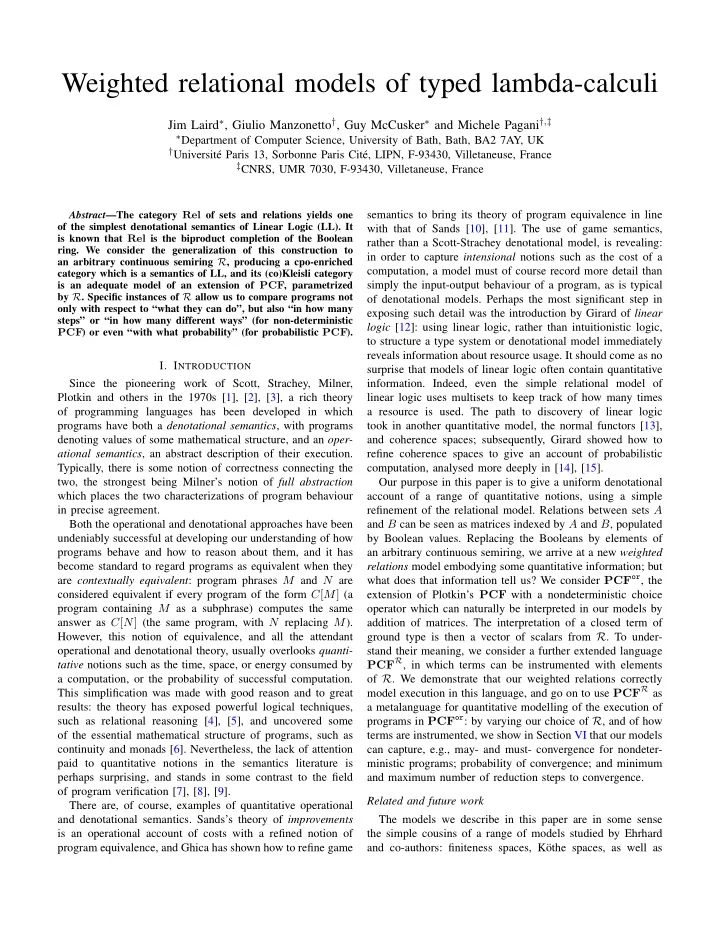

Weighted relational models of typed lambda-calculi Jim Laird ∗ , Giulio Manzonetto † , Guy McCusker ∗ and Michele Pagani † , ‡ ∗ Department of Computer Science, University of Bath, Bath, BA2 7AY, UK † Universit´ e Paris 13, Sorbonne Paris Cit´ e, LIPN, F-93430, Villetaneuse, France ‡ CNRS, UMR 7030, F-93430, Villetaneuse, France semantics to bring its theory of program equivalence in line Abstract —The category Rel of sets and relations yields one of the simplest denotational semantics of Linear Logic (LL). It with that of Sands [10], [11]. The use of game semantics, is known that Rel is the biproduct completion of the Boolean rather than a Scott-Strachey denotational model, is revealing: ring. We consider the generalization of this construction to in order to capture intensional notions such as the cost of a an arbitrary continuous semiring R , producing a cpo-enriched computation, a model must of course record more detail than category which is a semantics of LL, and its (co)Kleisli category simply the input-output behaviour of a program, as is typical is an adequate model of an extension of PCF , parametrized by R . Specific instances of R allow us to compare programs not of denotational models. Perhaps the most significant step in only with respect to “what they can do”, but also “in how many exposing such detail was the introduction by Girard of linear steps” or “in how many different ways” (for non-deterministic logic [12]: using linear logic, rather than intuitionistic logic, PCF ) or even “with what probability” (for probabilistic PCF ). to structure a type system or denotational model immediately reveals information about resource usage. It should come as no I. I NTRODUCTION surprise that models of linear logic often contain quantitative Since the pioneering work of Scott, Strachey, Milner, information. Indeed, even the simple relational model of Plotkin and others in the 1970s [1], [2], [3], a rich theory linear logic uses multisets to keep track of how many times of programming languages has been developed in which a resource is used. The path to discovery of linear logic programs have both a denotational semantics , with programs took in another quantitative model, the normal functors [13], denoting values of some mathematical structure, and an oper- and coherence spaces; subsequently, Girard showed how to ational semantics , an abstract description of their execution. refine coherence spaces to give an account of probabilistic Typically, there is some notion of correctness connecting the computation, analysed more deeply in [14], [15]. two, the strongest being Milner’s notion of full abstraction Our purpose in this paper is to give a uniform denotational which places the two characterizations of program behaviour account of a range of quantitative notions, using a simple in precise agreement. refinement of the relational model. Relations between sets A Both the operational and denotational approaches have been and B can be seen as matrices indexed by A and B , populated undeniably successful at developing our understanding of how by Boolean values. Replacing the Booleans by elements of programs behave and how to reason about them, and it has an arbitrary continuous semiring, we arrive at a new weighted become standard to regard programs as equivalent when they relations model embodying some quantitative information; but what does that information tell us? We consider PCF or , the are contextually equivalent : program phrases M and N are considered equivalent if every program of the form C [ M ] (a extension of Plotkin’s PCF with a nondeterministic choice program containing M as a subphrase) computes the same operator which can naturally be interpreted in our models by answer as C [ N ] (the same program, with N replacing M ). addition of matrices. The interpretation of a closed term of ground type is then a vector of scalars from R . To under- However, this notion of equivalence, and all the attendant operational and denotational theory, usually overlooks quanti- stand their meaning, we consider a further extended language PCF R , in which terms can be instrumented with elements tative notions such as the time, space, or energy consumed by of R . We demonstrate that our weighted relations correctly a computation, or the probability of successful computation. model execution in this language, and go on to use PCF R as This simplification was made with good reason and to great results: the theory has exposed powerful logical techniques, a metalanguage for quantitative modelling of the execution of programs in PCF or : by varying our choice of R , and of how such as relational reasoning [4], [5], and uncovered some of the essential mathematical structure of programs, such as terms are instrumented, we show in Section VI that our models continuity and monads [6]. Nevertheless, the lack of attention can capture, e.g., may- and must- convergence for nondeter- paid to quantitative notions in the semantics literature is ministic programs; probability of convergence; and minimum perhaps surprising, and stands in some contrast to the field and maximum number of reduction steps to convergence. of program verification [7], [8], [9]. Related and future work There are, of course, examples of quantitative operational and denotational semantics. Sands’s theory of improvements The models we describe in this paper are in some sense is an operational account of costs with a refined notion of the simple cousins of a range of models studied by Ehrhard program equivalence, and Ghica has shown how to refine game and co-authors: finiteness spaces, K¨ othe spaces, as well as
Recommend
More recommend